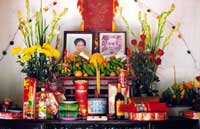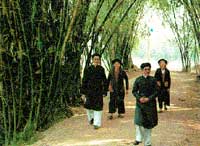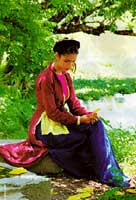
| Capital city | : Hanoi |
| National Population | : 85,789.6 thousand inhabitants (Apr. 2009) |
| Language | : Vietnamese |

A very popular belief among Vietnamese is the custom of the ancestor cult. In every household, an ancestor altar is installed in the most solemn location.
Worship of Ancestor Custom

Vietnamese believe that the soul of a dead person, even if dead for many generations, still rests along with their descendants on earth. The dead and living persons still have spiritual communion; in everyday life, people must not forget that what they enjoy and how they feel is the same for their dead relatives.
On the last day of every lunar year, an announcing cult, cung tien thuong, is performed to invite the dead forefathers to return home to celebrate Tet holidays with their families. During the last days before Tet, all family members visit their ancestors’ graves; they clean and decorate the graves, in the same manner that the livings clean and decorate their houses to welcome the New Year.
Villages – Guilds

The Vietnamese culture has always evolved on the basis of the wet rice civilization. Thus, the lifestyle of the Vietnamese population is closely related to its village and native lands.
In Vietnamese society, people gather together to form villages in rural areas, and guilds in urban areas. Villages and guilds have been forming since the dawn of the nation. These organizations have gradually developed for the population to be more stable and closer together. Each village and guild has its own regulations called conventions. The purpose of these conventions is the promotion of good customs within populations. All the conventions are different but they are always in accordance with the state laws.

From generation to generation, the Vietnamese people preserve the fine tradition of “remembering the source while drinking water.” Festivals are events which represent this tradition of the community as well as honour the holy figures named as “gods” – the real persons in national history or legendary persons. The images of gods converge the noble characteristics of mankind. They are national heroes who fought against foreign invaders, reclaimed new lands, treated people, fought against natural calamities, or those legendary characters who affect the earthly life. Festivals are events when people pay tribute to divinities that rendered merits to the community and the nation.

Festivals are occasions when people come back to either their natural or national roots, which form a sacred part in their mind.
Festivals represent the strength of the commune or village, the local region or even the whole nation. Worshipping the same god, the people unite in solidarity to overcome difficulties, striving for a happy and wealthy life.


For formal ceremonies men would have two additional items, a long gown with slits on either side, and a turban, usually in black or brown made of cotton or silk. In feudal times, there were strict dress codes. Ordinary people were not allowed to wear clothes with dyes other than black, brown or white. Costumes in yellow were reserved for the King. Those in purple and red were reserved for high ranking court officials, while dresses in blue were exclusively worn by petty court officials. Men's dress has gradually changed along with social development.
Young women wear light brown-colored short shirts with long black skirts. Their headgear consists of a black turban with a peak at the front. To make their waist look smaller, they tightly fasten a long piece of pink or violet cloth.On formal occasions, they wear a special three layered dress called an "ao dai", a long gown with slits on either side.
(Source: vietnamtourism.com)










